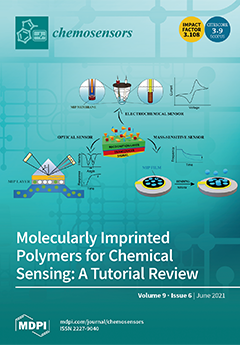In this work, the effect of fluorine and chlorine substituents in tetrasubstituted zinc phthalocyanines, introduced into the non-peripheral (ZnPcR
4-np, R = F, Cl) and peripheral (ZnPcR
4-p, R = F, Cl) positions of macrocycle, on their structure and chemiresistive sensor
[...] Read more.
In this work, the effect of fluorine and chlorine substituents in tetrasubstituted zinc phthalocyanines, introduced into the non-peripheral (ZnPcR
4-np, R = F, Cl) and peripheral (ZnPcR
4-p, R = F, Cl) positions of macrocycle, on their structure and chemiresistive sensor response to low concentration of ammonia is studied. The structure and morphology of the zinc phthalocyanines films (ZnPcR
4) were investigated by X-ray diffraction and atomic force microscopy methods. To understand different effects of chlorine and fluorine substituents, the strength and nature of the bonding of ammonia and ZnPcHal
4 molecules were studied by quantum chemical simulation. It was shown on the basis of comparative analysis that the sensor response to ammonia was found to increase in the order ZnPcCl
4-np < ZnPcF
4-np < ZnPcF
4-p < ZnPcCl
4-p, which is in good agreement with the values of bonding energy between hydrogen atoms of NH
3 and halogen substituents in the phthalocyanine rings. ZnPcCl
4-p films demonstrate the maximal sensor response to ammonia with the calculated detection limit of 0.01 ppm; however, they are more sensitive to humidity than ZnPcF
4-p films. It was shown that both ZnPcF
4-p and ZnPcCl
4-p and can be used for the selective detection of NH
3 in the presence of carbon dioxide, dichloromethane, acetone, toluene, and ethanol.
Full article





